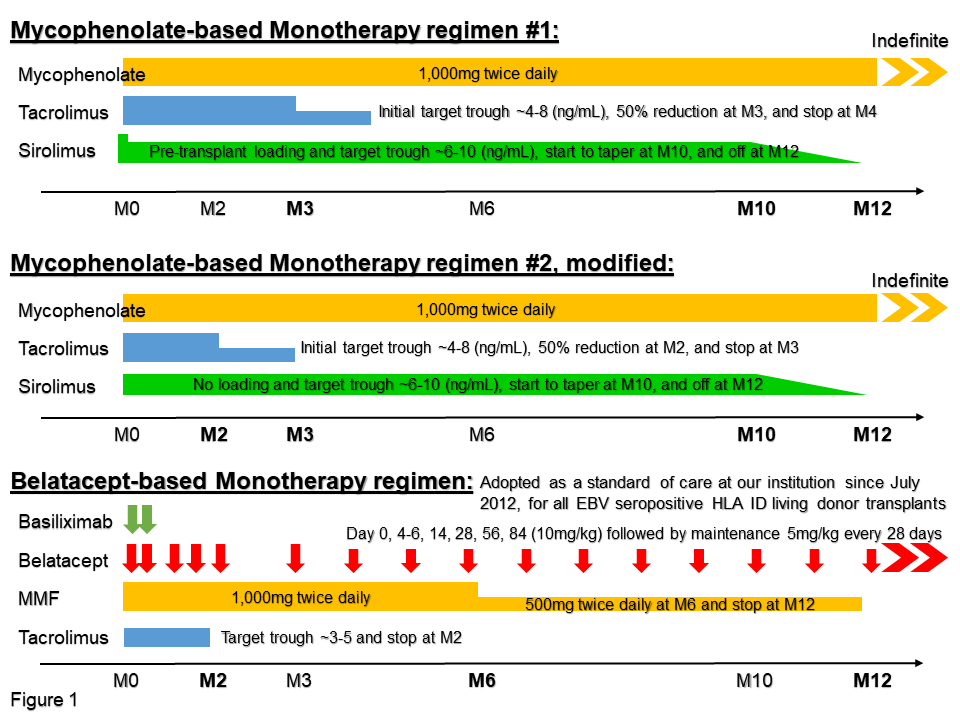Comparative Analysis of Belatacept and Mycophenolate Monotherapy-Based Regimens for HLA Identical Living Donor Kidney Transplantation
Univ. of Cincinnati, Cincinnati, OH
Meeting: 2019 American Transplant Congress
Abstract number: 314
Keywords: Graft survival, HLA matching, Kidney transplantation, Rejection
Session Information
Session Name: Concurrent Session: Kidney Immunosuppression: Novel Regimens and Drug Minimization II
Session Type: Concurrent Session
Date: Monday, June 3, 2019
Session Time: 4:30pm-6:00pm
 Presentation Time: 5:18pm-5:30pm
Presentation Time: 5:18pm-5:30pm
Location: Veterans Auditorium
*Purpose: HLA identical (HLA ID) living donor kidney transplants (KTx) provide long-term survival with substantially reduced rejection risk; aspects that can be exploited in designing immunosuppression (IS) minimization regimens. In this study, we compared belatacept (Bela) and mycophenolate (MYC)-based monotherapy with standard of care (SOC) in HLA ID KTx using the institutional database linked to Scientific Registry of Transplant Recipients (SRTR).
*Methods: We performed a matched cohort study of 300 HLA ID KTx: 60 recipients assigned to either Bela- or MYC-based regimen per our institutional protocol(Figure1); 240 controls derived from SRTR as CNI-based SOC.
Predefined endpoints included a combinatorial primary outcome of patient survival, graft survival or rejection, and renal graft function as a secondary endpoint.
*Results: Our cohort consisted of 15, 45, and 240 patients in Bela, MYC, and SOC, respectively. Baseline demographics were similar between groups except for viral serologies (Table1). Death-censored (DC) graft survival [n(%)] was Bela 15(100);MYC 38(84);SOC 214(89), p=0.25. DC-graft loss related to rejection was 57% and 69% in MYC and SOC, respectively. Outcomes at Year(Y) 3 are summarized in Table2.
Figures2 to 4 show survival analyses with no significant difference, p>.05. A proportion of recipients who achieved eGFR≥60mL/min/1.73m2 at Y1 was Bela 67%;MYC 33%;SOC 30%, p=0.29. This trend was maintained throughout the cohort period(Figure5).
*Conclusions: Bela monotherapy was associated with favorable outcomes and improved renal graft function, whereas higher graft loss was observed in MYC-based regimen. This initial experience with a belatacept-based regimen appears to provide an attractive alternative to current CNI-based IS protocols.
To cite this abstract in AMA style:
Yamada M, Meganathan K, Shields A, Brailey P, Tremblay S, Govil A, Alloway RR, Shah S, Woodle ES, Jawdeh BGAbu. Comparative Analysis of Belatacept and Mycophenolate Monotherapy-Based Regimens for HLA Identical Living Donor Kidney Transplantation [abstract]. Am J Transplant. 2019; 19 (suppl 3). https://atcmeetingabstracts.com/abstract/comparative-analysis-of-belatacept-and-mycophenolate-monotherapy-based-regimens-for-hla-identical-living-donor-kidney-transplantation/. Accessed January 5, 2026.« Back to 2019 American Transplant Congress



